
The Royal Flying Corps (RFC) was the air arm of the British Army before and during the First World War until it merged with the Royal Naval Air Service on 1 April 1918 to form the Royal Air Force. During the early part of the war, the RFC supported the British Army by artillery co-operation and photographic reconnaissance. This work gradually led RFC pilots into aerial battles with German pilots and later in the war included the strafing of enemy infantry and emplacements, the bombing of German military airfields and later the strategic bombing of German industrial and transport facilities.

Marshal of the Royal Air Force Hugh Montague Trenchard, 1st Viscount Trenchard, was a British officer who was instrumental in establishing the Royal Air Force. He has been described as the "Father of the Royal Air Force."

Number 99 Squadron is a squadron of the Royal Air Force which operates the Boeing C-17 Globemaster III strategic/tactical transport aircraft from RAF Brize Norton.

Marshal of the Royal Air Force Cyril Louis Norton Newall, 1st Baron Newall, was a senior officer of the British Army and Royal Air Force. He commanded units of the Royal Flying Corps and Royal Air Force in the First World War, and served as Chief of the Air Staff during the first years of the Second World War. From 1941 to 1946 he was the Governor-General of New Zealand.

No. 27 Squadron of the Royal Air Force operates the Boeing Chinook from RAF Odiham.
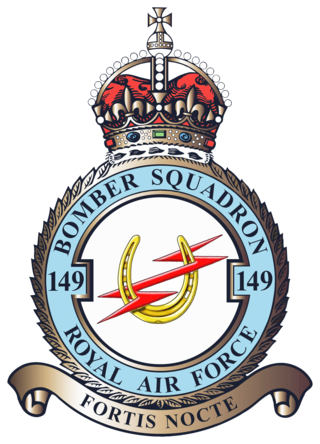
No. 149 Squadron RAF was a Royal Air Force Squadron between 1918 and 1956. Formed 1918 in the Royal Flying Corps as a night-bomber unit, it remained in that role for the rest of its existence which spanned three periods between 1918 and 1956.

No. 487 (NZ) Squadron was a light bomber squadron established for service during the Second World War. It was a New Zealand squadron formed under Article XV of the Empire Air Training Plan. Although many of its flying personnel were largely drawn from the Royal New Zealand Air Force, the squadron served in Europe under the operational and administrative command of the Royal Air Force as part of Bomber Command. Formed in mid-1942, it operated the Lockheed Ventura and then the de Havilland Mosquito and took part in over 3,000 operational sorties before being disbanded at the end of the war in late 1945.
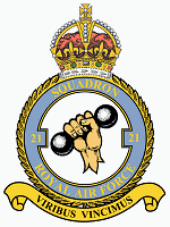
No. 21 Squadron of the Royal Air Force was formed in 1915 and was disbanded for the last time in 1979.

No. 40 Squadron of the Royal Air Force was formed in 1916 at Gosport as No. 40 Squadron Royal Flying Corps and was disbanded for the last time in 1957. The squadron also included many non-British members, including volunteers from the Royal Australian Air Force and Royal Canadian Air Force.
No. 61 Squadron was a squadron of the Royal Air Force. It was first formed as a fighter squadron of the British Royal Flying Corps during the First World War. It was reformed in 1937 as a bomber squadron of the Royal Air Force and served in the Second World War and after, until disbanded in 1958.

No. 463 Squadron RAAF was a Royal Australian Air Force heavy bomber squadron during World War II. The squadron was formed in the United Kingdom in late 1943 from personnel and aircraft allocated from No. 467 Squadron RAAF. The squadron was equipped with Avro Lancaster bombers and flew its first raids on Germany immediately after being formed. Operating as part of RAF Bomber Command No. 463 Squadron conducted raids against cities, industrial facilities and military targets in Germany, France and Norway throughout 1944 and until the end of the war in May 1945. Following the war, the squadron evacuated Allied prisoners of war from Europe until it was disbanded in late 1945.
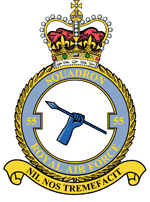
Number 55 Squadron was a flying squadron of the Royal Air Force (RAF). First formed in April 1917, the squadron saw action on the Western Front during the First World War. Based in the Middle East during the interwar period and the Second World War, No. 55 Squadron saw action over Iraq, Egypt, Libya and Italy. Between 1960 and 1993, the unit flew the Handley Page Victor. Initially on the Victor B.1A before becoming a tanker squadron in 1965 with the Victor B(K).1A/K.1/K.1A before converting to the Victor K.2 in 1975. Disbanding in October 1993, No. 55 Squadron were the last RAF unit to operate the Victor. Between 1996 and 2011, No. 55(Reserve) Squadron operated the Hawker Siddeley Dominie T.1 from RAF Cranwell, Lincolnshire, helping to train navigators for the RAF.
No. 608 Squadron was an Auxiliary Air Force squadron of the Royal Air Force during the Second World War. It flew during its existence as a bomber, fighter and reconnaissance unit and was the only RAF squadron to be equipped with the unsuccessful Blackburn Botha torpedo bomber.
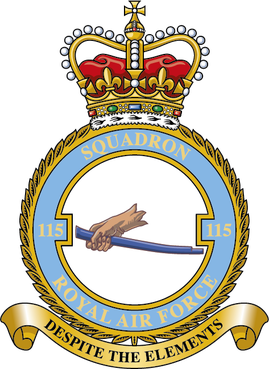
Number 115 Squadron is a Royal Air Force squadron operating the Grob Tutor T1, training QFIs for the RAF's Elementary Flying Training (EFT) squadrons and the University Air Squadrons, as well as undertaking evaluation and standardisation duties.
No. 571 Squadron RAF was a Second World War Royal Air Force pathfinder squadron operating the de Havilland Mosquito.

No. 627 Squadron was a Royal Air Force Mosquito aircraft pathfinder bomber squadron that operated during the Second World War.
No. 41 Wing of the Royal Flying Corps (RFC), later the Royal Air Force (RAF), was a division which conducted strategic bombing operations against Germany during the First World War.
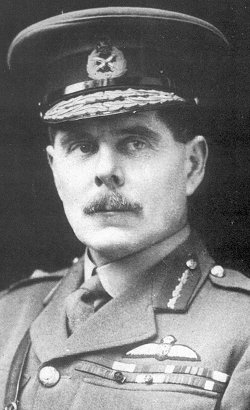
Hugh Trenchard was the commander of the Royal Flying Corps in France from 25 August 1915 until 2 January 1918.
No. 107 Squadron RAF was a Royal Flying Corps bomber unit formed during the First World War. It was reformed in the Royal Air Force during the Second World War and was operational during the Cold War on Thor Intermediate Range Ballistic Missiles.













